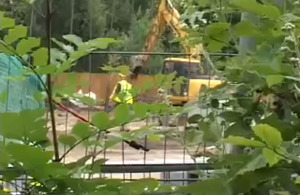New powers preventing unwanted 'garden grabbing'
Decentralisation Minister Greg Clark announces new plans to take gardens out of the brownfield category.

Building site viewed through a fence
Councils and communities are being given new powers to prevent the destructive practice of ‘garden grabbing’ and to decide what types of homes are suitable for their area, Greg Clark announced today (9 June 2010).
Map of local authority areas with high rates of garden grabbing
Over the last decade, many councils have been left frustrated at being unable to prevent a dramatic increase in the number of new houses being built on previously residential land such as people’s back gardens - up from 1-in-10 to 1-in-4 between 1997 and 2008.
Planning guidance has classified gardens as previously residential land’, in the same brownfield category as derelict factories and disused railway sidings, robbing communities of green breathing space, safe places for children to play and havens for urban wildlife.
Mr Clark is today unveiling plans to take gardens out of the Brownfield category, a simple step that will dramatically transform councils’ ability to prevent unwanted development on gardens where local people object and protect the character of their neighbourhoods.
Watch a video on garden grabbing
From today Mr Clark will also scrap the minimum density target, handing power back to town halls and local communities to decide what new homes are best for their area. The target has contributed to the lack of family sized homes and flats that local people need. Councils will now work with local communities and developers to deliver more family homes and affordable housing the local community.
Greg Clark said:
For years the wishes of local people have been ignored as the character of neighbourhoods and gardens have been destroyed, robbing communities of vital green space.
It is ridiculous that gardens have until now been classified in the same group as derelict factories and disused railway sidings, forcing councils and communities to sit by and watch their neighbourhoods get swallowed up in a concrete jungle.
Today I am changing the classification of garden land so councils and communities no longer have their decisions constantly overruled, but have the power to work with industry to shape future development that is appropriate for their area.
This is just the start of wholescale reform I want to make to the planning system, so councils and communities are centre-stage in a reformed system that works for them, and is not just a tool of top-down policy.
Housing Minister Grant Shapps said:
The current system with its push for high density has resulted in developers building 1 or 2 bedroom executive flats, when the greatest need is often for affordable family homes. That’s why from today communities will be allowed to make their own decisions about what homes are needed in their area, and no longer be victims of a system designed to maximise profits and minimise choice.
Dr Simon Thornton Wood, Director of Science and Learning at the Royal Horticultural Society said:
We welcome any measure that protects the vital resource we know gardens to be. Gardens like parks, are the green lungs of cities, improving air quality, controlling air temperature and flood risk and providing a haven for wildlife. Beyond these very practical benefits of gardens we know that gardening is great for physical and mental health. That’s why we would like planning measures to go further than protecting existing gardens, to guarantee high quality green space and gardening opportunities in all new building developments, wherever they are.
Richard Bashford - Project Manager, RSPB said:
Gardens are mini nature reserves on our doorsteps and vital habitats for all sorts of wildlife. Many much loved species rely on green spaces like gardens, such as the song thrush and house sparrow, both of which have suffered massive declines in the last few years. House sparrow numbers have plummeted by over 60% and we have lost almost 75% of song thrushes. If more garden space is turned into buildings they will likely decline further and the wonder that children experience on the doorstep will dwindle.
We hope that the new measures will protect the habitats of species that have become synonymous with English gardens and demonstrate a rich eco system in our own back yards such as frogs, toads and bumble bees.
Facts on garden grabbing
- recent government figures for 2008 show that 80% of homes were built on brownfield land, up from 56% in 1997; this incorporates development on previously residential land that includes gardens, which has risen nationally from 11% to 23% between 1997 and 2008, but is much higher in some local areas (see the spreadsheet below)
- new build statistics show the decline in the number of houses built has largely been for 4+ bed houses, with small declines in 2 and 3 bed houses; there has been a corresponding proportionate increase in 2 bed flats